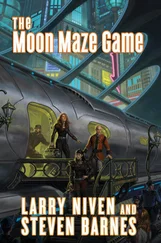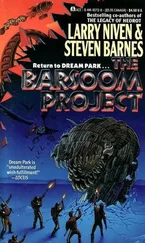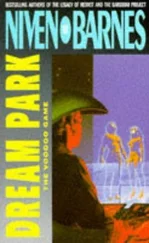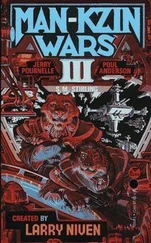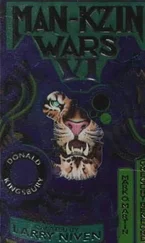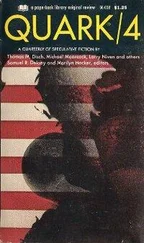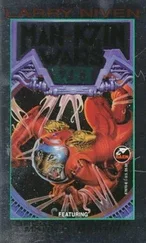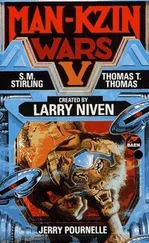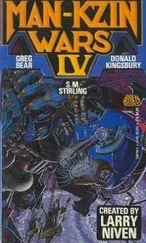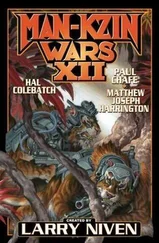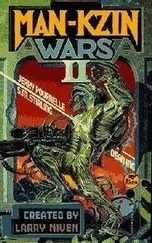Both midshipmen looked suddenly alert. Bury asked,
“What would physical evolution of humans bring, my lady?”
“They used to teach us that evolution of intelligent beings wasn’t possible,” she said. “Societies protect their weaker members. Civilizations tend to make wheel chairs and spectacles and hearing aids as soon as they have the tools for them. When a society makes war, the men generally have to pass a fitness test before they’re allowed to risk their lives. I suppose it helps win the war.” She smiled. “But it leaves precious little room for the survival of the fittest.”
“But suppose,” Whitbread suggested, “suppose a culture were knocked even further back than Makassar? All the way to complete savagery: clubs and fire. There’d be evolution then, wouldn’t there?”
Three glasses of wine had overcome Sally’s black mood, and she was eager to talk of professional matters. Her uncle often told her she talked too much for a lady, and she tried to watch herself, but wine always did it to her—wine and a ready audience. It felt good, after weeks of nothingness.
“Certainly,” she said. “Until a society evolved. You’d have natural selection until enough humans got together to protect each other from the environment. But it isn’t long enough. Mr. Whitbread, there is a world where they practice ritual infanticide. The elders examine children and kill the ones who don’t conform to their standards of perfection. It’s not evolution, exactly, but you might get some results that way—except that it hasn’t been long enough.”
“People breed horses. And dogs,” Rod observed.
“Yes. But they haven’t got a new species. Ever. And societies can’t keep constant rules long enough to make any real changes in the human race. Come again in a million years— Of course there were the deliberate attempts to breed supermen. Like Sauron System.”
Sinclair grunted. “Those beasties,” he spat. “ ’Twas they started the Secession Wars and nearly killed the lot o’ us.” He stopped suddenly as Midshipman Whitbread cleared his throat.
Sally jumped into the lull. “That’s another system I can’t be sympathetic with. Although they’re Empire loyalists now.” She looked around. Everyone had a strange look, and Sinclair was trying to hide his face behind a tilted wineglass. Midshipman Horst Staley’s angular face might have been carved from stone. “What’s the matter?” she asked.
There was a long silence. Finally Whitbread spoke. “Mr. Staley is from Sauron System, my lady.”
“I—I’m sorry,” Sally blurted. “I guess I really put my foot in it, didn’t I? Really, Mr. Staley, I’m…”
“If my young gentlemen can’t take that much pressure, I don’t need them in my ship,” Rod said. “And you weren’t the only one to put your foot in it.” He looked significantly at Sinclair. “We don’t judge men by what their home worlds did hundreds of years ago.” Damn . That sounds stilted. “You were saying about evolution?”
“It—it ought to be pretty well closed off for an intelligent species,” she said. “Species evolve to meet the environment. An intelligent species changes the environment to suit itself. As soon as a species becomes intelligent, it should stop evolving.”
“A pity we don’t have any others for comparison,” Bury said easily. “Only a few fancied ones.” He told a long story about an improbably intelligent octopoid meeting a centaur, and everyone laughed. “Well, Captain, it was a fine dinner,” Bury ended.
“Yes.” Rod stood and offered Sally his arm, and the others scrambled to their feet. She was quiet again as he escorted her through the corridor to her cabin, and only polite as they parted. Rod went back to the bridge. More repairs had to be recorded into the ship’s brain.
Hyperspace travel can be strange and frustrating.
It takes an immeasurably short time to travel between stars: but as the line of travel, or tramline, exists only along one critical path between each pair of stars (never quite a straight line, but close enough to visualize it so) and the end points of the paths are far from the distortions in space caused by stars and large planetary masses, it follows that a ship spends most of its time crawling from one end point to another.
Worse than that, not every pair of stars is joined by tramlines. Pathways are generated along lines of equipotential thermonuclear flux, and the presence of others stars in the geometric pattern can prevent the pathway from existing at all. Of those links that do exist, not all have been mapped. They are difficult to find.
MacArthur ’s passengers found that travel aboard an Imperial warship was akin to imprisonment. The crew had duties to perform and repairs to make even when off watch. The passengers had each other’s company, and what social life Navy routine would permit. There was no place for the entertainment facilities that luxury liners would carry.
It was boring. By the time MacArthur was ready for her last Jump, the passengers saw their arrival in New Caledonia as a release from jail.
NEW CALEDONIA: Star system behind the Coal Sack with F8 primary star catalogued as Murcheson A. The distant binary, Murcheson B, is not part of the New Caledonia system. Murcheson A has six planets in five orbits, with four inner planets, a relatively wide gap containing the debris of an unformed planet, and two outer planets in a Trojan relationship. The four inner planets are named Conchobar, New Ireland, New Scotland, and Fomor, in their order from the sun which is known locally as Cal, or Old Cal, or the Sun. The middle two planets are Inhabited, both terraformed by First Empire scientists after Jasper Murcheson, who was related to Alexander IV, persuaded the Council that the New Caledonian system would be the proper place to establish an Imperial university. It is now known that Murcheson was primarily interested in having an inhabited planet near the red super giant known as Murcheson’s Eye, and as he was not satisfied with the climate of New Ireland demanded the terraforming of New Scotland as well.
Fomor is a relatively small planet with almost no atmosphere and few interesting features. It does, however, possess several fungi which are biologically related to other fungi found in the Trans-Coalsack Sector, and their manner of transmission to Fomor has stimulated an endless controversy in the Journal of the Imperial Society of Xenobiologists, since no other life forms native to New Caledonia exist.
The two outer planets occupy the same orbit and are named Dagda and Mider in keeping with the system’s Celtic mythological nomenclature. Dagda is a gas giant, and the Empire maintains fuel stations on the planet’s two moons, Angus and Brigit. Merchant ships are cautioned that Brigit is a Navy base and may not be approached without permission.
Mider is a cold metal ball, extensively mined, and troublesome to cosmologists because its manner of formation does not appear to conform to either of the two major contending theories of planetary origin.
New Scotland and New Ireland, the only inhabited planets of the system, had extensive atmospheres of water vapor and methane when discovered, but no free oxygen. Biological packages in massive quantities transformed them into inhabitable worlds at considerable cost; toward the end of the project Murcheson lost his influence in the Council but by then the investment was so high that the project was carried on to completion. In less than a hundred years of intensive effort the domed colonies became open colonies, one of the most triumphant accomplishments of the First Empire.
Both worlds were partially depopulated during the Secession Wars, with New Ireland joining the rebel forces while New Scotland remained staunchly loyalist. After interstellar travel was lost in the Trans-Coalsack Sector, New Scotland continued the struggle until its rediscovery by the Second Empire. As a consequence, New Scotland is the Trans-Coalsack Sector Capital.
Читать дальше


